Kimi no Iru Machi

Kimi no Iru Machi does shounen romance like a cup of fresh milk. It’s frill-free and yet enjoyable. Sure, you could always add chocolate, bananas or space-alien girls to create a more exotic blend, but sometimes it’s nice to just savour that pure unaltered taste of simplicity.
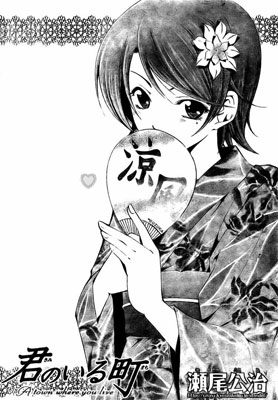
The genre of shounen love comedy is mostly dominated by two archetypes: harem and girl-with-special-powers. Often a mixture of both. This is the result of a variety of factors, such as economical imperatives (i.e. maximising merchandising potential) and a need to differentiate one’s work from the rest in a highly saturated market. Love comedies that do not rely on either belong to, for the most part, the exclusive domain of shoujo (and are often written from a female perspective), a sad situation for people like me who are forced to secretly read pink-covered volumes of Kare Kano behind locked doors.
KimiMachi, featuring neither harem nor supernatural phenomenons, represents an increasingly rare sub-genre that has long been under-catered for: the pseudo shoujo. It consists of plot devices and character development that wouldn’t feel out of place in a typical teenage romance novel, but retains the art style and presentation that identifies it as shounen work. It’s basically a recognition that not all sentimental sop fests have to be targeted at female readers — just most of them.
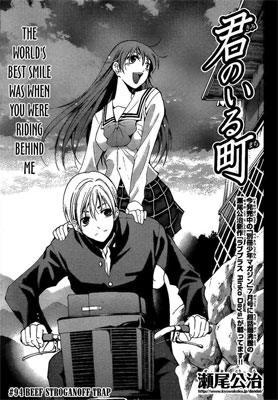
KimiMachi is author Kouji Seo‘s follow-up to Suzuka, the series that started off as a better-drawn copy of Love Hina but made some people go “WTF” in the end where certain unexpected events transpired. I expect similar plot twists from KimiMachi and so far it looks like it will not disappoint.
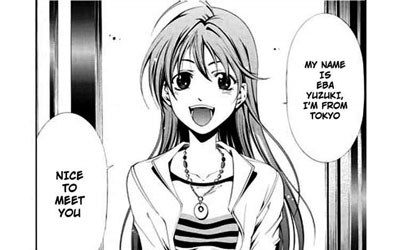
Set two years after the end of Suzuka in a small town in what is today Shoubara, Hiroshima (the author’s hometown), the story of KimiMachi features a completely new cast of characters with occasional off-stage cameos by Suzuka characters. Haruto Kirishima has a huge crush on his classmate Nanami Kanzaki. One day, a strange girl named Yuzuki Eba suddenly moves into his house and transfers to his school. A love triangle ensues.
The initial set-up of the story appears generic at first sight, but, just as Suzuka started off as an apparent clone of Love Hina, it is the subsequent development that sets KimiMachi apart.
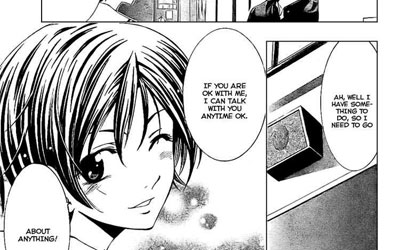
The great thing about KimiMachi is its unpredictability. Of course, it’s not completely unpredictable to the point that Yuzuki turns out to be an alien from the Andromeda Galaxy (fresh milk, remember?), but it does a good job of steering the story to unexpected directions. Every time it feels like the story has established a new status quo and you think you know what happens next, the story throws a monkey wench at your face and breaks your nose (eh, maybe that’s not the right metaphor). It goes like this:
You: “I’ve read enough love comedies to know that she is not going to confess her real feelings right now because that’s how the story prolongs itself.”
Story: “Screw your preconceptions. Here’s her doing exactly that.”
You: “WTF, so the story is over?”
Story: “Nope.”
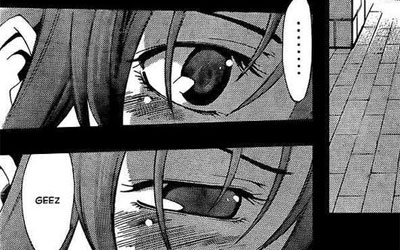
Whereas the typical love comedy likes to condemn the main characters to a perpetual state of relationship limbo (i.e. more than friends, less than lovers, with the occasional longing stare) until the author finally decides to end the story with a Happily Ever After™, KimiMachi is perfectly willing to allow its characters to confront every situation directly to keep the story moving. Unlike the typical loser male leads whose popularity with girls defies logic, Haruto as a character is likeable and easy to empathize with because he tries to deal with problems proactively instead of merely being swept along by the story.
It’s quite hard for me to go any deeper about what I think of the storywriting without giving out spoilers, and I hate spoilers more than genocide. So, you’ll just have to take my word that it’s pretty good.
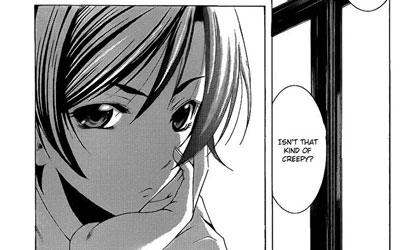
I also like the fact that the author incorporates his personal experiences into the story. From the cool Hiroshima dialect (which unfortunately does not translate at all into English) to the background art created from photographs of his hometown, KimiMachi feels a lot more personal and homely than his previous work, Suzuka. I wouldn’t be surprised if some of the characters or situations are based on his own high school memories. The short introductions he gives to various places around his hometown on the cover fold of each volume help to add that little extra touch of realism.
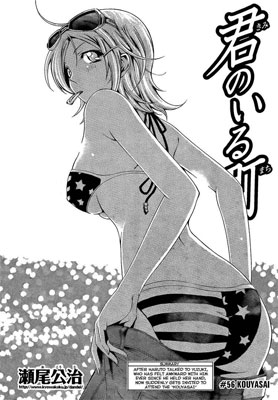
Art-wise, I find KimiMachi to be an improvement over Suzuka, albeit more evolutionary than revolutionary. Scene compositions are more varied and effective, characters don’t blend into overly complicated backgrounds and the line art in general feels more polished. The drawings are functional and serve to enhance the storytelling without the occasional distracting awkwardness that can be found in Suzuka and Seo’s older workers. All in all, I think his style is maturing nicely.
Conclusion
Kimi no Iru Machi is a really enjoyable series. It has a fast-moving plot that constantly keeps you at the edge and manages to keep thing fresh for the most part. Ten volumes later and it has yet to disappoint. Wonder if it will get an anime adaptation soon?
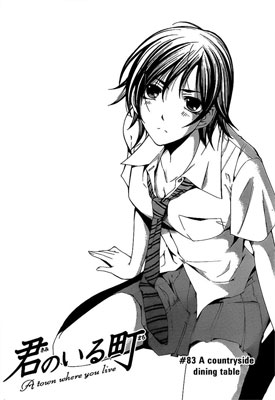
Tsundere







August 1st, 2010 at 2:41 pm
Dude, I thought you died and reincarnated in azeroth or something. I guess the RSS feed was still around.
Nice come back article. I liked Suzuka (only saw the anime) so I’ll definitely be checking this out. I stopped watching/reading romance material because they all apply the same friggin formula over and over again. I even started predicting their lines before they even say them…pisses me off.
Anyway, hope you keep up with the articles, just remember to keep the quality good, quality > quantity.
edit: WTH canadian flag… should be usa…
August 1st, 2010 at 3:33 pm
First Canned Dogs, now DM?! Welcome back from the dead :)
10 volumes, eh? Is it very text heavy or does it proceed at a relatively quick pace? Might pick it up when I run out of Tsukihime again.
August 1st, 2010 at 3:53 pm
Great article. I just finished watching Suzuka and now I will need to check this out. Think it will be released in the US?
August 1st, 2010 at 5:04 pm
I’ve been following KimiMachi since it’s started and while I can’t say I quite like all the twists it’s throwing to at the readers, it’s undeniably fresh and keeps the story from getting stale.
Although I must say the guys in this series act like real idiots at times.
I don’t know how far ahead you’ve read, but the latest chapter sure is one of those chapters where the guys act like an ass. Especially Haruto’s new “best friend” telling him to take a certain someone as his GF in case shit happens.
August 2nd, 2010 at 12:40 am
I never did give Suzuka a chance. Love Hina redux was pretty much my reaction to the first episode. Maybe I should give it another chance.
Otherwise, great article, will read again. A+++
Heh heh, this series has me interested by how your describing it (romance comedy with no gimmicks? Inconceivable!)
August 2nd, 2010 at 9:14 pm
The way that you’ve described it would make me immensely interested in this story had I not already been reading it.
Problem is, I have. I can’t say it is all that enjoyable, and a majority of foreign and Japanese fans alike share my sentiments of “WTF” at the developments in this story. Basically, the characters are all either under-developed or one dimensional and the actions the hero and heroine take are often illogical or if they’ve been rationalized away, the rationalization is always a failure.
There is a series that is within this same sub-genre called Good Ending that I believe you should read, I feel it is done properly.
August 2nd, 2010 at 11:01 pm
HE’S ALIVE!!!!!!!!!!!!
August 5th, 2010 at 1:57 am
Wow, when you said you had regained your enthusiasm for blogging you were not kidding.
If this comes to the United States, I will most likely purchase it. I understand your pains, reading manga with embarrassing covers.
I look forward to your coming torrent of posts.
August 6th, 2010 at 11:57 am
I just read till chapter 100 of his manga, and i must say that its really good. Its just like you said, the mangaka is a genius i dont know how he comes with these ideas. I thought that the story was over at the end of vol 6 but then the story just kept getting better and better.
I really like this story because you never really know what will happen next, and when you think you know…BAM!! it hits you in the back of your head with a baseball bat!!
August 7th, 2010 at 1:31 pm
i just read the first 3 chapters today. you were quite right in your praise of this manga. thanks for the recommendation! we’re all very glad that you’re back =]
August 8th, 2010 at 1:01 am
Soulshift: The verbosity is average for shounen. Nowhere near Kare Kano level.
LostGamer: Well, who knows. I’m guessing it should find its way there if it gets an anime adaptation.
Kurogane: I’m up to the latest volume, which is 10. I don’t read by chapters because I read the Japanese tankoubon. And I won’t say that they are idiotic, merely confused and misguided. Heh.
Ramune: I actually found Suzuka enjoyable, the manga much more than the anime.
Kenneth: Wow, harsh. While I agree that the characters are mostly expendable, I think they aren’t exceptionally one-dimensional or underdeveloped when you look at shounen titles in general. And the WTF-ness is really the enjoyable part of the whole thing, because I find that this genre suffers particularly badly from predictable tropes. Maybe it’s just me.
August 17th, 2010 at 3:03 pm
Kind of a late comment, but I took up your recommendation to read up to date on the chapters. I honestly didn’t know that Seo was working on a another series after Suzuka. Stupid me didn’t think to check. Seems you already tackled most of the criticism, I’ll skip that. I really enjoyed how both series’ journey for love unrolls, down-to-earth story but always tugged along to the next development.
Fun fact, after reading Suzuka four years ago, I actually jointed my college’s track team. Seo’s work would always have a special place in my book.